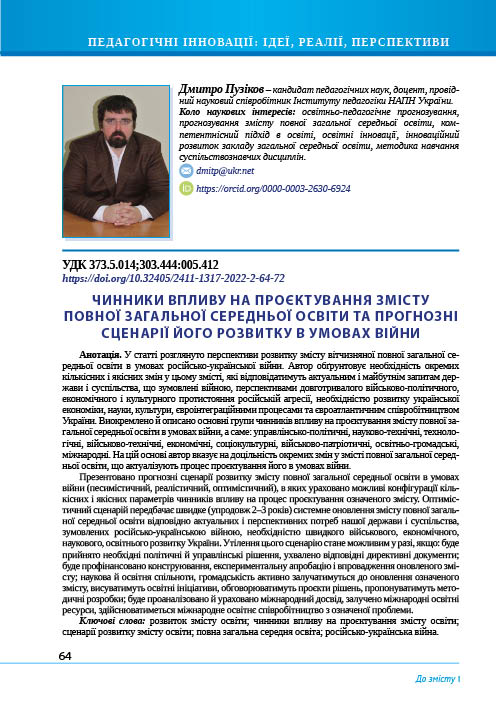Abstract
The article considers the prospects for the development of the content of domestic complete general secondary education in wartime. The author substantiates the need for certain quantitative and qualitative changes in this content, which will meet the current and future demands of the state and society due to the war, prospects for long-term military-political, economic and cultural resistance to russian aggression, the need for the Ukrainian economy, science, culture, European integration processes and Euro-Atlantic cooperation of Ukraine. The main groups of factors influencing the design of the content of complete general secondary education in wartime are identified and described, namely: administrative-political, scientific-technical, technological, military-technical, economic, socio-cultural, military-patriotic, educational, public, international. On this basis, the author points out the expediency of certain changes in the content of complete general secondary education, which actualize the process of designing it in wartime.
Forecasting scenarios of the general secondary education content development in wartime (pessimistic, realistic, optimistic) are presented, which take into account possible configurations of quantitative and qualitative parameters of factors influencing the process of designing this content. The optimistic scenario envisages rapid (within 2–3 years) systematic updating of the content of complete general secondary education in accordance with the current and future needs of our state and society due to the russian-Ukrainian war, the need for rapid military, economic, scientific and educational development of Ukraine. Implementation of this scenario will be possible if: the necessary political and administrative decisions will be made, the relevant policy documents will be adopted; the design, experimental testing and implementation of updated content will be funded; the scientific and educational community, the public will be actively involved in updating the content, put forward educational initiatives, discuss draft decisions, propose methodological developments; international experience will be analysed and taken into account, international educational resources will be involved, and international educational cooperation on this issue will be implemented.
References
Бондар, В.І. (2005). Дидактика. Київ: Либідь.
Кизенко, В.І. (2018). Варіативний компонент змісту освіти в основній і старшій школі: теорія і практика: монографія. Київ: Видавничий Дім «Слово».
Пузіков, Д.О. (2018). Prognostic model of the Ukraine system of general secondary education development: forecasting scenarios of the development. Український педагогічний журнал, 4 (16), 45–53. https://doi.org/10.32405/2411–1317–2018–4–45–53.
Редько, В.Г. (2017). Конструювання змісту підручників з іноземних мов: теорія і практика: монографія. Київ: Педагогічна думка.
Савченко, О.Я. (2013). Дидактика початкової освіти: підруч. для вищ. навч. закл. 2-ге вид. Київ: Грамота.
Савченко, О.Я. (2021). Зміст загальної середньої освіти. Енциклопедія освіти. Київ: Юрінком-Інтер.
Топузов, О.М. (2021). Освітнє партнерство в системі загальної середньої освіти: теорія і методологія: монографія. Київ: Інститут педагогіки: Педагогічна думка.
Bell, S., and Huebler, F. (2011). The quantitative impact of conflict on education, UIS technical paper, no. 7, UNESCO-UIS, Montreal, from http://unesdoc.unesco.org/images/0021/002145/214576e.pdf.
Cervantes-Duarte, L., and Fernández-Cano, A. (2016). Impact of Armed Conflicts on Education and Educational Agents: A Multivocal Review. Revista Electrónica Educaree (Educare Electronic Journal), 20(3), 1–24. http://dx.doi.org/10.15359/ree.20–3.12.
Giordano, G. (2004). Wartime Schools: How World War II Changed American Education. New York: Peter Lang.
Hartman, A. (2011). Education and the Cold War: The Battle for the American School. New York: Palgrave Macmillan.
Justino, P., Marinella L., and Paola S. (2014). Short- and Long-Term Impact of Violence on Education: The Case of Timor Leste. The World Bank Economic Review 28(2): 320–53. https://doi.org/10.1093/wber/lht007/
Agbor, M. N., Etta, M. A., and Etonde, H. M. (2022). Effects of armed conflicts on teaching and learning: Perspectives of secondary school teachers in Cameroon. Journal of Education, 88. doi: http://dx.doi.org/10.17159/2520–9868/i86a09.
Topuzov, O., and Puzikov, D. (2018). Development of content of general secondary education: analysis of forecast background. Education: Modern Discourses, 1(1), 142–150. https://doi.org/10.32405/2617–3107–2018–1–13.
Bondar, V.I. (2005). Dydaktyka. Kyiv: Lybidj. (in Ukrainian).
Kyzenko, V.I. (2018). Variatyvnyj komponent zmistu osvity v osnovnij i staršij školi: teorija i praktyka: monohrafija. Kyjiv: Vydavnyčyj Dim «Slovo». (in Ukrainian).
Redko, V.H. (2017). Konstruiuvannia zmistu pidruchnykiv z inozemnykh mov: teoriia i praktyka: monohrafiia. Kyiv: Pedahohichna dumka. (in Ukrainian).
Savchenko, O. Ja. (2021). Zmist zahal'noji seredn'oji osvity. Entsyklopediia osvity. Kyiv: Yurinkom-lnter. (in Ukrainian).
Savchenko, O. Ja. (2013). Dydaktyka pochatkovoji osvity: pidruch. dlja vyshh. navch. zakl. (2nd ed.). Kyiv: Ghramota. (in Ukrainian).
Puzikov, D. (2018). Prognostic model of the Ukraine system of general secondary education development: forecasting scenarios of the development. Ukrainskyi pedahohichnyi zhurnal, 4 (16), 45–53. https://doi.org/10.32405/2411–1317–2018–4–45–53.
Topuzov, O. (2021). Osvitnje partnerstvo v systemi zahal'noji seredn'oji osvity: teorija i metodolohija: monohrafija. Kyjiv: Instytut pedahohiky: Pedahohichna dumka. (in Ukrainian).
Bell, S., and Huebler, F. (2011). The quantitative impact of conflict on education, UIS technical paper, no. 7, UNESCO-UIS, Montreal, from http://unesdoc.unesco.org/images/0021/002145/214576e.pdf.
Cervantes-Duarte, L., and Fernández-Cano, A. (2016). Impact of Armed Conflicts on Education and Educational Agents: A Multivocal Review. Revista Electrónica Educaree (Educare Electronic Journal), 20(3), 1–24. http://dx.doi.org/10.15359/ree.20–3.12.
Giordano, G. (2004). Wartime Schools: How World War II Changed American Education. New York: Peter Lang.
Hartman, A. (2011). Education and the Cold War: The Battle for the American School. New York: Palgrave Macmillan.
Justino, P., Marinella L., and Paola S. (2014). Short- and Long-Term Impact of Violence on Education: The Case of Timor Leste. The World Bank Economic Review 28(2): 320–53. https://doi.org/10.1093/wber/lht007/
Agbor, M. N., Etta, M. A., and Etonde, H. M. (2022). Effects of armed conflicts on teaching and learning: Perspectives of secondary school teachers in Cameroon. Journal of Education, 88. doi: http://dx.doi.org/10.17159/2520–9868/i86a09.
Topuzov, O., and Puzikov, D. (2018). Development of content of general secondary education: analysis of forecast background. Education: Modern Discourses, 1(1), 142–150. https://doi.org/10.32405/2617–3107–2018–1–13.

This work is licensed under a Creative Commons Attribution-NonCommercial-ShareAlike 4.0 International License.


